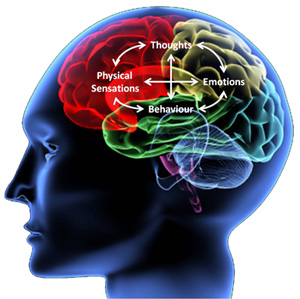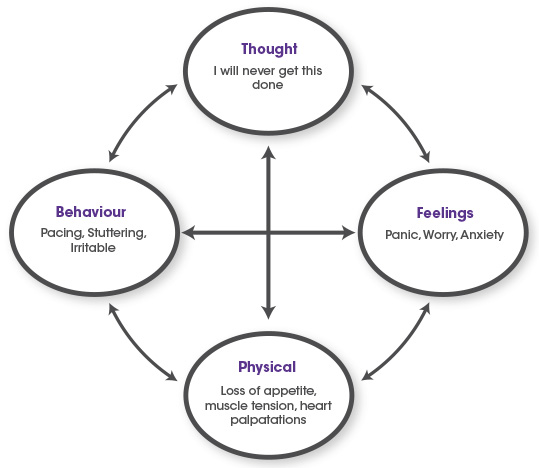Cognitive Behavioural Therapy
Cognitive Behavioural Therapy combines cognitive and behavioural therapies and has strong empirical support for treating a number of problems including eating disorders, anxiety disorders, mood...
The basic premise of Cognitive Behavioural Therapy is that emotions are difficult to change directly, so the approach targets emotions by changing thoughts and behaviours that are contributing to the distressing emotions. Cognitive Behavioural Therapy builds a set of skills that enables an individual to be aware of thoughts and emotions; identify how situations, thoughts, and behaviours influence emotions; and improve feelings by changing dysfunctional thoughts and behaviours. The process of Cognitive Behavioural Therapy skill acquisition is collaborative. Skill acquisition and homework assignments are what set CBT apart from other talking therapies. The direct contact time between counsellor and client is used to learn skills to address the presenting problem and not simply to discuss the issue. With Cognitive Behavioural Therapy it is normal to have between four and eight sessions and to concentrate on specific treatment for a limited number of the client's problems. It’s necessary to focus on one or two specific problems because of the limited number of sessions and because the client is required to use extra reading materials and homework to assist therapeutic growth. Cognitive Behavioural Therapy can range in duration from client to client and counsellor to counsellor and clients are encouraged to think flexibly in determining length of treatment, however the idea that there are not going to be endless sessions is important to the nature of this approach. Time-limited therapy offers an additional incentive for clients and counsellors to work efficiently and effectively.
With Cognitive Behavioural Therapy it is normal to have between four and eight sessions and to concentrate on specific treatment for a limited number of the client's problems. It’s necessary to focus on one or two specific problems because of the limited number of sessions and because the client is required to use extra reading materials and homework to assist therapeutic growth. Cognitive Behavioural Therapy can range in duration from client to client and counsellor to counsellor and clients are encouraged to think flexibly in determining length of treatment, however the idea that there are not going to be endless sessions is important to the nature of this approach. Time-limited therapy offers an additional incentive for clients and counsellors to work efficiently and effectively.
Cognitive Behavioural Therapy can help you to change how you think ("Cognitive") and what you do ("Behaviour)". These changes can help you to feel better. Unlike some other talking treatments, it focuses on the "here and now" of problems and difficulties. Whilst it is often useful to discuss the past and understand how our pasts have influenced our lives and how problems have arisen, CBT mostly focuses on looking for ways to improve mental wellbeing now.
The Cognitive Behavioural Therapy approach says that it is not the event which causes our emotions, but how we interpret that event – what we think or what meaning we give that event or situation. For instance, if someone you know passes you in the street without acknowledging you, you can interpret it several ways. You might think they don't want to know you because no-one likes you (which may lead you to feel depressed), your thought may be that you hope they don't stop to talk to you, because you won't know what to say and they'll think you're boring and stupid (anxiety), you may think they are being deliberately snotty (leading to anger). A healthier response might be that they just didn't see you.
Another example may be someone who is depressed might wake up in the morning and think: "This is going to be another awful day", "I am going to mess up again", or "What's the point of anything?", which will make them feel even more depressed (feelings), and may prompt them to pull the covers over their head and stay in bed (behaviours). It is very likely that this will increase their negative thoughts, which in turn will increase the feelings of depression, and make them even less likely to get out of bed. A vicious cycle is the result – continuing to think and act the same way will help maintain our depression. CBT can help you to break these vicious cycles of negative thinking, feelings and behaviour. When you see the parts of the vicious cycle clearly, you can change them – and therefore change the way you feel. It can also be useful to look at the way our thoughts and feelings affect our bodies, and the physical sensations we can experience. 
Cognitive Behavioural Therapy aims to get you to a point where you can "do it yourself", and work out your own ways of tackling problems. CBT has often been described as guided self-help, and this self-help course will help you learn how CBT can help you. The following self-help steps will enable you, with or without the help of a therapist or mental health professional, to gain some useful insights and begin to address and work through your problems. An initial part of the cognitive behavioural assessment involves setting the scene of the therapeutic relationship and the style of the treatment. This also serves to increase agreement between the counsellor and clients’ expectations of therapy, which will strengthen the therapeutic alliance and assist to retain clients in therapy. An important focus of a cognitive behavioural intervention is that it emphasises the possibility of change, rather than dwelling on problems. This sense should be conveyed to the client during the assessment session and throughout treatment.
Cognitive Behavioural Therapy is largely self-help and aims to be active and collaborative. The counsellor’s role is to help the client develop skills and tools that will assist them to overcome their current problem. These skills can also be utilised to combat future problems and prevent relapse. In the first few sessions, the counsellor usually prepares the client for the active role they will have in therapy. This may involve the completion of homework tasks in the real life setting.
Alternatively, the client could be encouraged to have an active role in counselling, including:
• contributing to the development of hypotheses regarding their problem.
• coming up with homework exercises.
• giving feedback on the exercises.
• making suggestions about alternative strategies for coping.
Cognitive Behavioural Therapy acknowledges that, for behaviour change to be sustainable, new behaviours or tools must be practiced and implemented outside of the counselling room. The treatment is highly collaborative and the client is expected to have "expert" information about their problem and the contexts in which it occurs. Cognitive behavioural interventions also seek to educate clients about the nature of the problem and how external variables (situation and behaviours) relate to internal variables (thoughts and feelings).